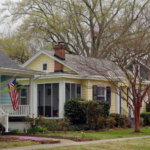by James C. Sherlock
Dick Hall-Sizemore did a nice job earlier today describing the phenomenon in which people are specifically against in a particular iteration public policies that they support in the abstract.
The subject was middle income housing in Arlington County.
The problem with short articles by anyone (including me) about housing issues is they cannot begin to account for all of the government interventions in housing at the federal, state and local levels as well as forces like inflation in the general economy that disrupt the housing market before forces in that single market take effect.
We see this week articles and op-eds flood the press that take a stand on — mostly to criticize — Governor Youngkin’s announced goal to increase the housing stock.
They tend to be at best misleading — inflating his potential effect on housing in order to say he is not doing enough.
No governor, by design of the Code of Virginia and the vastness of the market, can have anything but a very minor effect on housing.
The federal government hand is very heavy here.
To sighs of relief, I won’t go through it all, but there are more federal housing-related programs than Carter has pills, including the huge and occasionally dysfunctional impacts of federal insuring and purchasing of loans.
In Virginia, Title 36. Housing of the Code of Virginia creates a very complex web of state and local authorities.
The governor can ask the General Assembly for more money for the Virginia Housing Trust Fund (VHTF). But that fund is by statute controlled by the Virginia Housing Development Authority (VHDA) and by the Board of Housing and Community Development (BHCD), both of which have independent appointees.
The VHTF was funded by the budget at $55 million for FY2022. I hear that there are other claims on the budget.
Housing Forward Virginia, an advocacy group, claims that
In the last four years, every one dollar from the (V)HTF resulted in an additional $30 leveraged from federal, local, and private funding. These sources include the other streams wrapped into ASNH (Affordable and Special Needs Housing) and VCI (Vibrant Community Initiative), Low-Income Housing Tax Credits from Virginia Housing (VHDA), and additional grants and loans from local governments.
I have no way of verifying that claim.
But all of those federal grants and loans come with formulas mandated for their use. And even if that multiplier is accurate, the full effect of the VHTF was only $1.6 billion in FY 2022.
Virginia home sales in 2021 totaled $67 billion.
VHDA and BHCD also carry out the regulatory work. The BHCD’s constantly revised state building codes are enormous contributors to cost.
At the local level, there are the state-chartered regional Housing Authorities in those localities that have established them.
City and county councils make zoning decisions. Under enormous pressures as illustrated in Jim’s article.
Then there are land use regulations for many buildable plots of land — flood zones, historic zones, special zones of all descriptions and laws against adverse impacts on protected classes.
Bottom line. All of those buttons, pulleys and levers may be desirable in theory, some are even necessary, but the result is a Rube Goldberg housing enterprise in Virginia.
We all want that machinery to function efficiently and effectively. We all expect it will not.
But then we get to market forces that include inflation, mortgage rates, supply chains and labor.
I point all of this out to indicate that attributing to any governor powers over the housing market is a chimera.



